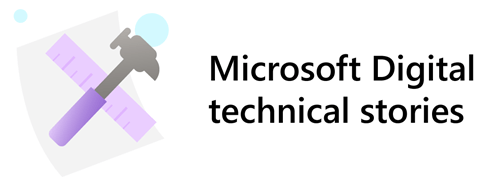
Nobody helps employees adopt a new tool like their peers—the people who know their responsibilities, their organizational culture, and their day-to-day tasks.
In the initial stages of our Microsoft 365 Copilot adoption, a technology that brings many new possibilities and ways of working to the table, we knew we needed an unconventional approach to change management. At Microsoft Digital, the company’s IT organization, we understand that peer-to-peer support is one of the most powerful levers for driving excitement, engagement, education, and action for employees.
We turned to a grassroots approach to adoption support: The Copilot Champs Community.
New technology needs a new approach to adoption
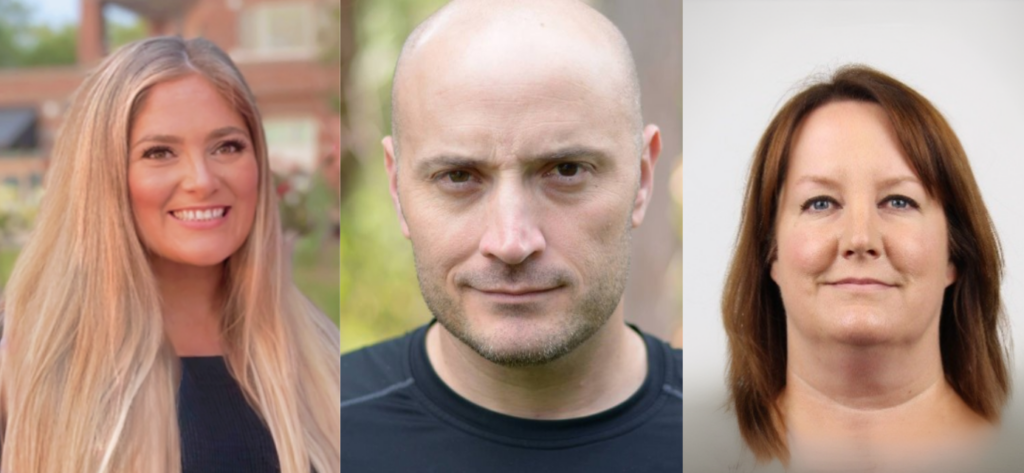
As we began our Microsoft 365 Copilot rollout, it quickly became apparent that a community-based approach would be particularly powerful for this technology. That’s because individual people use Copilot in ways that are highly specific to their work and organization.
So, although Microsoft Digital has an extremely robust team of change management professionals, we could never hope to address the needs and culture of every organization across the company. We also recognized that excitement for Copilot was leading many of our employees to dive in headfirst and become early super-users when it came to applying this tool to their roles.
“The way to get people to really adopt a change is to make it relevant to their roles, and you achieve that by showing them the value of that change,” says Lisa Fryc, director of business program management on Microsoft Digital’s readiness team. “Peer-to-peer adoption efforts create a trusted environment where people can get the best information from their own community members.”
From a centralized change management perspective, our role at Microsoft Digital becomes providing the “one front door” to the assets and resources employees need, then relying on community support to direct employees to the material most relevant to their work. The result is a hub-and-spoke model that involves both core and local change management teams working to empower the Copilot Champs Community.
The internal benefits of our Copilot Champs Community
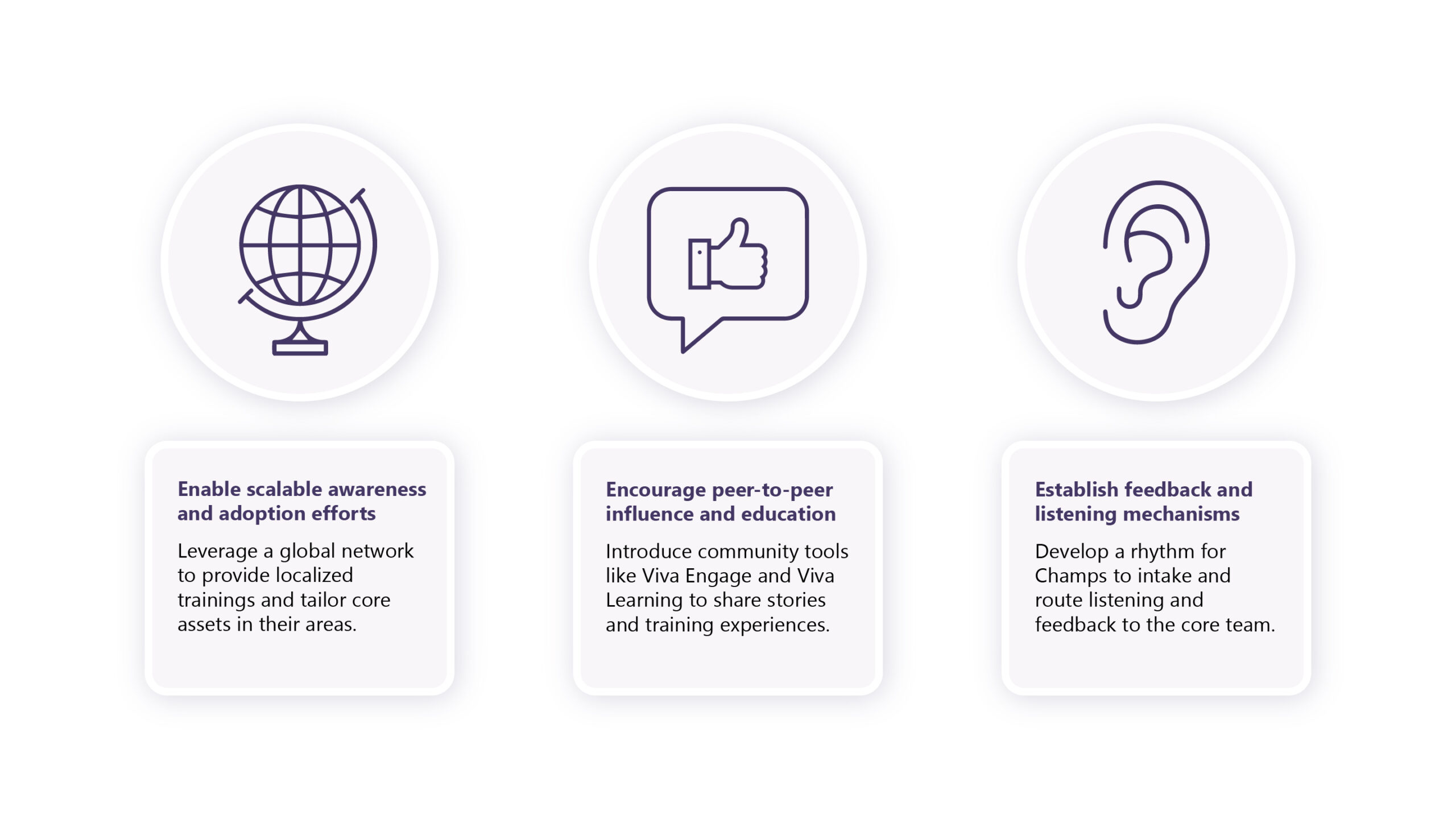
“People learn better peer-to-peer,” says Cadie Kneip, readiness business program manager responsible for the Copilot Champs Community on Microsoft’s Digital team. “Everyone has their own learning style, so our job is to develop training material and package it in a way that peer leaders can grab hold of and customize for their specific audience.”
Building a community that drives change
Although Microsoft has always encouraged culturally driven change initiatives, we’ve never run a champs program of quite this scale or sophistication. Microsoft 365 Copilot called for all-in peer-to-peer adoption efforts with a structured, targeted approach.
“We have an internal culture of peer-to-peer knowledge generosity,” Kneip says. “You can always find someone in a specific area of the world or organization who can touch on their colleagues’ concerns—it’s just a matter of bringing them on board.”
Microsoft Digital’s Employee Experience Success team developed a strategy for building our Copilot Champs Community, then nurturing champs as adoption leaders. It started with establishing the community, a process that continues as the team grows.
- Recruiting: We seek out and reward enthusiasm and provide a relatively open door to our Champs Community. That way, we can find enthusiastic participants who can appeal to all audiences.
- Welcome communications: We reach out to our prospective champs through Teams or email with a message welcoming them to the team, links to key resources including our baseline Copilot training, and opportunities to engage immediately.
- Branding: After our champs complete their required training and onboarding, they receive a Copilot Champs Community badge that serves two functions: signaling to their peers that they’re a source of guidance for Copilot and motivating the champs themselves through recognition.
- Kick-off call: Calls for new members help set expectations, foster excitement, and familiarize champs with their Microsoft Digital point of contact.
- Baseline poll: We try to establish a baseline for our champs’ existing Copilot familiarity, their eagerness to participate, and the assets that will be most useful for them.

These elements provided a steady influx of enthusiastic champs. From there, it was up to community leadership to make sure they were ready to support their peers.
“There’s more to managing a champs community than sending out a newsletter,” says Chad Hawthorne, director of business program management for Digital Experience, Readiness, and Change Management. “We recognized that, despite their deep knowledge, our Copilot super-users aren’t professional trainers, so we had to develop ways to give them assets and coaching to deliver effective peer-to-peer adoption.”
Our Champs Community nurture path includes the following elements:
- Viva Engage: A Viva Engage community created specifically for champs is our forum for posting announcements, encouraging discussions, and showcasing wins.
- Teams channel: We manage housekeeping, access to group files, contact with subject matter experts, and private discussions through an exclusive Teams channel.
- Train-the-trainer sessions: These live training sessions are crucial for enabling champs to host adoption activations such as lunch-and-learn or power hour trainings for their own teams.
- Community calls: A regular cadence of community calls lets our core adoption team showcase new features, go over housekeeping items, celebrate wins, share best practices, and generally keep the excitement and engagement rolling.
- Shout-outs: We use corporate communications channels to highlight champ stories that we can share as blog posts or leaders can use to give kudos to teams.
Setting champs free to lead
We discovered that a properly established and nurtured Copilot Champs Community quickly produces highly effective peer leaders.
Yen Anderson and Brian Shaw are two of our almost 4,500 champs and counting. Both started their Microsoft 365 Copilot journey as eager early adopters, and the community has given them a forum to share their expertise.
“As soon as I knew Copilot would become a broadly available enterprise tool, I knew the future of work would be changing,” says Anderson, Copilot champ and senior customer success account manager for Azure and AI. “And because I ramped up early, I was already demoing it to my team so they could see its value.”
Much of our champs’ activities take place in demonstration sessions. Shaw typically conducts 1–2 of these per week. Champs are also active in localized or organizational Viva Engage groups, which provide the perfect forum for ongoing conversations, showcasing learning, and community building.
“I love seeing people just light up,” says Shaw, Copilot champ and principal customer success account manager for RCG. “The technology is so impactful that people understand how it can change their work as soon as they see a demonstration.”
After a champ-led session, there’s a valuable opportunity for follow-up and relationship building. That only reinforces our champs’ position as peer leaders and makes them ideal support for their colleagues, further unburdening our centralized change management professionals.
Anderson and Shaw’s experiences are characteristic of champs across the community. Their expertise and innovation are as diverse as their roles.

Role
Senior customer success account manager, Azure and AI
Copilot expertise
Yen is a master of the art of the prompt. She’s honed her skills to develop prompts that save time on organizational tasks, boost productivity, and enhance creativity.
An innovation she’s shared
Yen specializes in helping peers craft the perfect prompts to meet their needs. With a keen interest in the mechanics of prompting, she helps her colleagues get on the path to advanced AI assistance by starting small, then introducing greater and greater specificity to their Copilot instructions.
“I love showing people how transformative generative AI tools can be,” Anderson says.

Role
Senior product manager, Microsoft Digital
Copilot expertise
Arias is committed to the ethical use of Copilot while using it actively in his own product management work. He takes an academic stance toward Copilot, with its capabilities at the center of his ongoing doctoral thesis.
An innovation he’s shared
Arias demonstrates ways to refine prompts in tandem with the principles of product management as expressed through the PMI framework. He encourages peers to use persona-based, goal-oriented prompts to put Copilot in the human-like headspace it needs to garner the results they want.
“Copilot helps me craft well-structured sentences for my communications, ensuring clarity and efficacy,” Arias says.
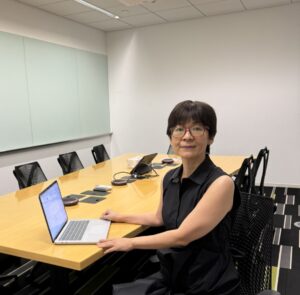
Roles
Business program manager, Greater China Region
Copilot expertise
As a business program manager, Cheng is responsible for driving adoption. She specializes in providing trainings from the beginner to advanced levels on using Copilot in Excel and Word.
An innovation she’s shared
Cheng is both an expert in using Copilot and a change management professional, so she’s pioneered ways to demonstrate the value of Copilot to her audience. Key strategies include real-time co-navigation of processes and using Copilot in Bing to drive self-learning.
“Find real business scenarios that your audience is interested in to attract users to try Copilot and keep using it consistently,” Cheng says.
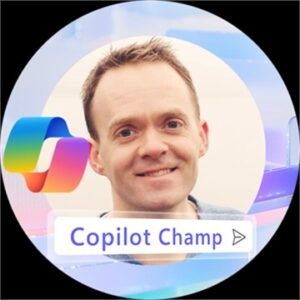

Roles
Members of the Engineering, Data, Operations, and Tools (EDOT) Business Partners and Planning team
Copilot expertise
Harris and Wilson’s work often requires collaboration with remote team members, which they’ve learned to automate through Copilot.
An innovation they’ve shared
Together, Harris and Wilson have developed a simple IP kit that lets peers run Copilot-fueled collaboration sessions to create plans that include action items and owners.
“We love showing people how Copilot can supercharge collaboration and help unleash collective potential, empowering teams to achieve more together,” Wilson says.
For them, it’s all about enabling our employees to collaborate in more powerful ways.
“There’s a ton of potential for employees to use Copilot to work better together,” Harris says.
He called out how they’re already using it this way in many Microsoft 365 applications.
“It’s accelerating joint brainstorming, idea affinization, and action planning through tools like Microsoft Whiteboard and Loop, which foster creativity and efficiency,” he says.

Role
Principal customer success account manager, RCG
Copilot expertise
As someone with an engineering background, Shaw is intimately familiar with the ways Copilot in Microsoft Power Platform can drastically increase efficiency for developers through low-code/no-code app creation. In fact, he helped develop the automated onboarding process for the growing Copilot Champs Community by using Power Automate.
An innovation he’s shared
Shaw has become an expert in helping users navigate the multiple modalities of accessing Copilot across their day-to-day workflows: App-specific, Copilot in Bing, and interfacial elements that emerge in the flow of work. He opens the black box of behind-the-scenes AI operations to help people bridge what they’re trying to accomplish with how to access it via Copilot.
“Copilot is one of the only tools out there that will teach you how to use it. You just have to find the right questions to ask,” Shaw says.
Empowering leaders, enabling employees
This approach to driving adoption has produced outstanding results so far. With almost 4,500 champs and counting, the community has become a self-perpetuating engine of growth and empowerment. The Champs Community is also a valuable vehicle for sharing product feedback and helping the Microsoft 365 Copilot product group improve the tool itself.
“Change management is a critical role within large enterprises as many companies are realizing more and more when attempting to improve or evolve business processes and IT systems that directly benefit users,” says Andrew Osten, general manager of business operations and programs for Employee Experience Success. “What our team has done is invest time and talent into crafting an operationalized adoption program with many proven techniques that can be leveraged to accelerate both end user and company ROI from business and IT investments.”
The Copilot Champs Community is continually developing new and ingenious workflows for using Copilot in everyday work. They include building finance reports, creating videos and decks by combining textual and visual generative AI elements, ideation assistance, and other role-based use cases—all of which blossom out into greater productivity and creativity for employees across Microsoft.
“In every champ session our community runs, it takes just one magical use case to turn a skeptic into a champion or power user,” Kneip says. “It’s that easy to flip the switch, and it’s that moment we capture with a well-structured Champs Community.”
If you want to implement a Copilot Champs Community in your organization, use this resource to plan and implement your peer-to-peer adoption efforts.

Here are some tips for getting started with a champs community at your company:
- Use immediate incentives to help people work toward mastery. Start with small wins that progress toward greater proficiency.
- Let champs tailor the experience for their own peers. That includes subdividing champ groups according to organizational needs.
- Start with surveys about utilization. Find the people who are most engaged and give them opportunities.
- When you’re cultivating early adopters, look for the generalists—people who know a little about a lot of different areas.
- Start with community channels like Teams and Viva Engage. Viva Engage is especially valuable because it encourages ongoing conversations, engagement, and communities of practice.
- Encourage communities to keep track of time savings and other ROI metrics.

New to Microsoft 365 Copilot? Try it out at your organization today.






